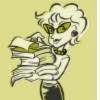 Johnson, D.B. 2007. FOUR LEGS BAD, TWO LEGS GOOD! Boston: Houghton Mifflin Company. ISBN 978-0-618-80909-7. $16.00.
Johnson, D.B. 2007. FOUR LEGS BAD, TWO LEGS GOOD! Boston: Houghton Mifflin Company. ISBN 978-0-618-80909-7. $16.00.While most of the animals of the No-Man Farm are working hard to keep it running, Orvie the pig is not. When Duck discovers Orvie is a lazy despot rather than a hard-working farmer, he decides to do something about it. Duck pulls the plug on their routine challenging the validity of the way things are.
Johnson’s layout includes Picasso-like, mixed media illustrations and hand-lettered text. Many pages are presented in a series of comic book frames and conversations are presented in speech bubbles. This format is likely to hold young readers’ attention by illustrating sequencing and dialog. Though this book may prove to be over the heads of its primary audience, its usefulness is clear. The lazy pig and pestering duck are sure to strike a chord with young children. Give this book several readings if you want to catch all the details creatively peppered throughout its pages.
“Slightly cubist, cartoon-like illustrations in mixed media capture the lighthearted politics of this comic animal farm.” (Kirkus Review, 2007)
“…More than a few adults sharing it with kids will be tempted to revisit the classic.” (School Library Journal, 2007)
Recommended use: Read aloud, story time, or independent reading for children ages 5-12 years. This is a good story for discussing team work and equality as well as more weighty topics such as oppression and prejudice.
 Henkes, Kevin. 2006 (Spanish translation, 2008). EL GRAN DÍA DE LILY. New York: Greenwillow Books. ISBN 978061363160
Henkes, Kevin. 2006 (Spanish translation, 2008). EL GRAN DÍA DE LILY. New York: Greenwillow Books. ISBN 978061363160




